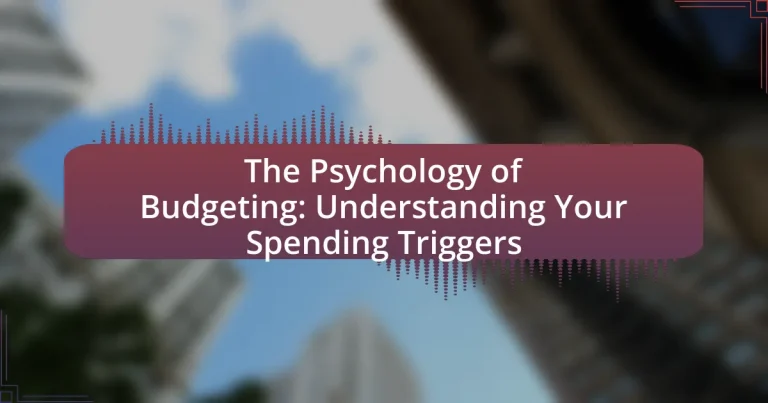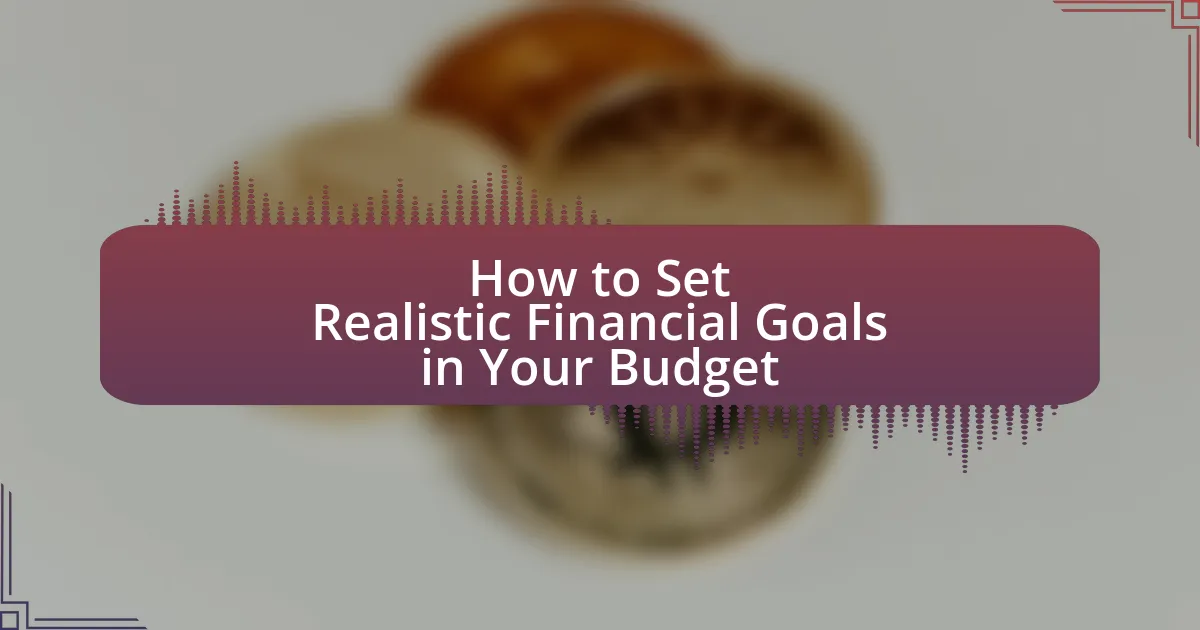The main entity of the article is the psychology of budgeting, which explores the mental and emotional factors influencing financial planning and resource management. The article examines how cognitive biases, emotional triggers, and social pressures affect spending behavior, highlighting the importance of self-awareness and recognizing spending triggers for effective budgeting. Key psychological factors such as impulse spending, financial anxiety, and the impact of marketing tactics are discussed, along with strategies to manage these influences. Additionally, the article emphasizes the role of goal setting, regular budget reviews, and practical techniques to enhance financial decision-making and promote disciplined spending habits.
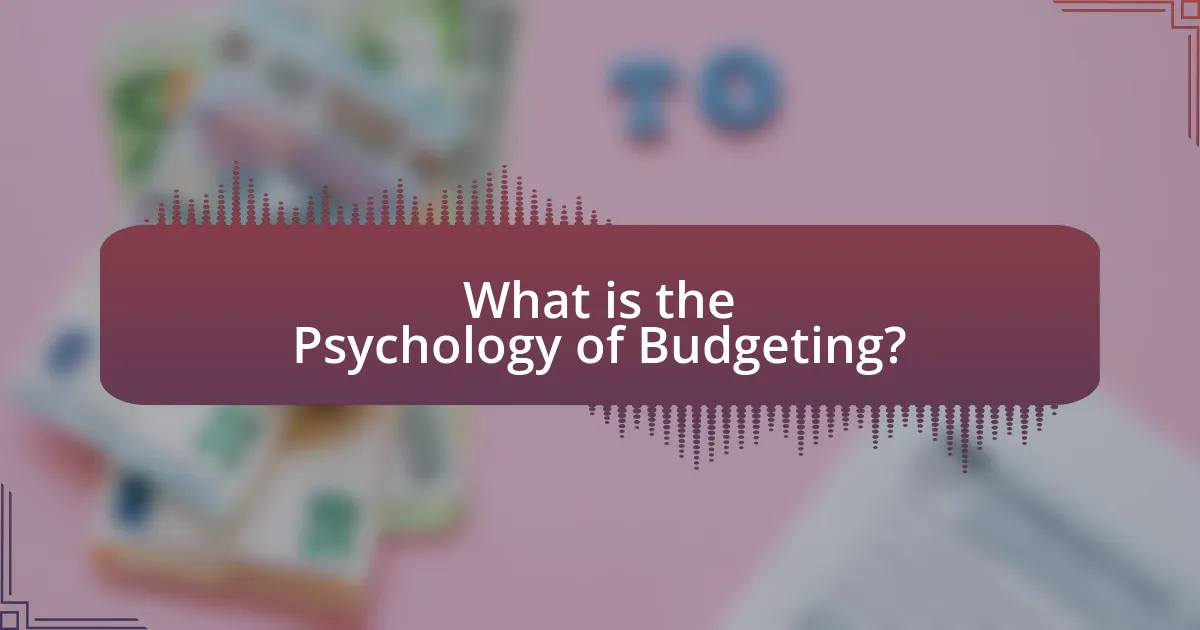
What is the Psychology of Budgeting?
The psychology of budgeting refers to the mental and emotional factors that influence how individuals plan, allocate, and manage their financial resources. This field examines behaviors such as impulse spending, financial anxiety, and the impact of cognitive biases on budgeting decisions. Research indicates that emotional triggers, such as stress or social pressure, can lead to deviations from planned budgets, while positive reinforcement and goal-setting can enhance adherence to budgeting practices. Understanding these psychological elements is crucial for developing effective budgeting strategies that align with personal financial goals.
How does understanding psychology influence budgeting decisions?
Understanding psychology significantly influences budgeting decisions by revealing the cognitive biases and emotional triggers that affect spending behavior. For instance, individuals often fall prey to the anchoring effect, where initial price information skews their perception of value, leading to poor budgeting choices. Research by Tversky and Kahneman highlights how cognitive biases can distort financial decision-making, demonstrating that awareness of these psychological factors enables individuals to create more effective budgets. By recognizing emotional triggers, such as impulse buying driven by stress or social pressure, individuals can implement strategies to mitigate these influences, ultimately leading to more disciplined financial management.
What are the key psychological factors that affect spending behavior?
Key psychological factors that affect spending behavior include emotional influences, cognitive biases, social pressures, and individual values. Emotional influences, such as stress or happiness, can lead to impulsive purchases as individuals seek to enhance their mood or alleviate negative feelings. Cognitive biases, like the anchoring effect, can cause consumers to rely heavily on initial price information, affecting their perception of value. Social pressures, including the desire to conform to peer behaviors or societal expectations, can drive individuals to spend beyond their means. Lastly, individual values, such as the importance placed on material possessions versus experiences, significantly shape spending habits. Research indicates that these factors collectively influence consumer decision-making processes, leading to varied spending behaviors across different demographics.
How do emotions play a role in budgeting and spending?
Emotions significantly influence budgeting and spending behaviors. Emotional states such as stress, happiness, or sadness can lead individuals to make impulsive financial decisions, often resulting in overspending or neglecting budgetary constraints. Research indicates that people experiencing negative emotions are more likely to engage in retail therapy, spending money to alleviate their feelings, which can disrupt financial plans. A study published in the Journal of Consumer Research found that individuals who reported higher levels of emotional distress were more prone to impulsive purchases, highlighting the direct correlation between emotional well-being and financial decision-making.
Why is it important to recognize spending triggers?
Recognizing spending triggers is important because it enables individuals to identify the emotional or situational factors that lead to impulsive purchases. By understanding these triggers, people can develop strategies to manage their spending behavior effectively. Research indicates that emotional spending accounts for a significant portion of consumer behavior, with studies showing that up to 60% of individuals make unplanned purchases driven by emotions such as stress or boredom. This awareness allows for better financial decision-making and helps in creating a more sustainable budget.
What are common spending triggers that individuals face?
Common spending triggers that individuals face include emotional states, social influences, and marketing tactics. Emotional states such as stress, boredom, or happiness can lead to impulsive purchases as individuals seek to alleviate negative feelings or enhance positive ones. Social influences, including peer pressure or the desire to fit in, often drive spending behaviors, particularly in group settings where individuals may feel compelled to spend to maintain social status. Additionally, marketing tactics, such as sales promotions, advertisements, and limited-time offers, create a sense of urgency that can prompt individuals to make unplanned purchases. Research indicates that these triggers significantly impact consumer behavior, with studies showing that emotional spending accounts for a substantial portion of retail purchases.
How can identifying triggers improve budgeting practices?
Identifying triggers can significantly improve budgeting practices by enabling individuals to recognize and manage emotional or situational factors that lead to impulsive spending. When individuals understand their spending triggers, such as stress, social pressure, or specific environments, they can develop strategies to mitigate these influences, leading to more disciplined financial behavior. Research indicates that people who actively track their emotional responses to spending are more likely to adhere to their budgets, as they can anticipate and counteract these triggers effectively. For instance, a study published in the Journal of Consumer Research found that consumers who identified their emotional spending triggers reduced their impulsive purchases by 30% over three months. This demonstrates that awareness of triggers not only fosters better budgeting but also promotes long-term financial stability.
What role does self-awareness play in budgeting?
Self-awareness plays a crucial role in budgeting by enabling individuals to recognize their spending habits and emotional triggers. This understanding allows people to make informed financial decisions, leading to more effective budget management. Research indicates that self-aware individuals are better at identifying unnecessary expenses and aligning their spending with their financial goals, which ultimately enhances their ability to stick to a budget. For instance, a study published in the Journal of Consumer Research found that individuals with higher self-awareness are more likely to engage in proactive financial planning and avoid impulsive purchases.
How can self-reflection enhance financial decision-making?
Self-reflection enhances financial decision-making by allowing individuals to critically assess their spending habits and motivations. This introspection helps identify emotional triggers that lead to impulsive purchases, enabling more informed and rational financial choices. Research indicates that individuals who engage in self-reflection are better at recognizing patterns in their behavior, which can lead to improved budgeting and savings strategies. For instance, a study published in the Journal of Consumer Research found that self-reflective practices can reduce impulsive buying by increasing awareness of personal values and long-term goals.
What techniques can help increase self-awareness regarding spending?
Techniques that can help increase self-awareness regarding spending include tracking expenses, setting spending limits, and reflecting on emotional triggers. Tracking expenses through apps or journals allows individuals to see where their money goes, providing concrete data that highlights spending patterns. Setting spending limits creates boundaries that encourage mindful purchasing, reinforcing awareness of financial goals. Reflecting on emotional triggers, such as stress or social pressure, helps individuals understand the motivations behind their spending, leading to more intentional financial decisions. Research indicates that self-monitoring and emotional awareness are key components in developing better financial habits, as evidenced by studies showing that individuals who track their spending are more likely to stick to budgets and reduce unnecessary expenses.
How can understanding your spending triggers lead to better budgeting?
Understanding your spending triggers can lead to better budgeting by enabling individuals to identify and manage emotional or situational factors that influence their purchasing decisions. When people recognize specific triggers, such as stress, social pressure, or advertising, they can develop strategies to avoid impulsive spending and allocate their resources more effectively. Research indicates that individuals who track their spending triggers are more likely to adhere to their budgets, as they can anticipate and mitigate situations that lead to overspending. For example, a study published in the Journal of Consumer Research found that consumers who were aware of their emotional spending patterns were able to reduce unnecessary expenses by up to 30%. This awareness fosters a proactive approach to budgeting, ultimately leading to improved financial health.
What strategies can be employed to manage spending triggers?
To manage spending triggers, individuals can employ strategies such as identifying triggers, setting a budget, and practicing mindfulness. Identifying triggers involves recognizing specific situations or emotions that lead to impulsive spending, which can be achieved through tracking expenses and reflecting on spending habits. Setting a budget provides a clear framework for spending, helping individuals allocate funds for necessities while limiting discretionary spending. Practicing mindfulness encourages individuals to pause and evaluate their emotional state before making purchases, reducing impulsive decisions. Research indicates that individuals who actively engage in these strategies report improved financial well-being and reduced impulsive spending behaviors.
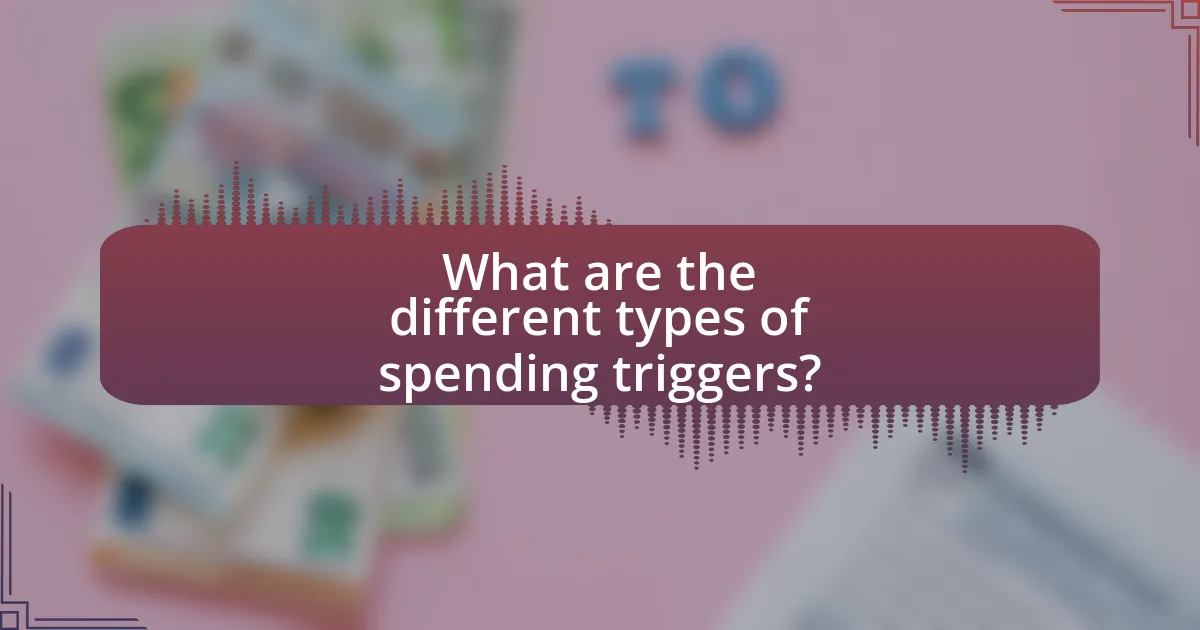
What are the different types of spending triggers?
The different types of spending triggers include emotional triggers, environmental triggers, social triggers, and cognitive triggers. Emotional triggers arise from feelings such as stress or happiness, prompting individuals to spend as a coping mechanism or reward. Environmental triggers are influenced by external factors like advertisements or store displays that encourage impulsive purchases. Social triggers stem from peer pressure or the desire to fit in, leading individuals to spend to maintain social status. Cognitive triggers involve mental shortcuts or biases, such as the perception of scarcity or discounts, which can distort decision-making and lead to unnecessary spending. Understanding these triggers is essential for effective budgeting and financial management.
How do external factors influence spending behavior?
External factors significantly influence spending behavior by shaping consumer perceptions and decisions. Economic conditions, such as inflation rates and unemployment levels, directly affect disposable income and purchasing power, leading consumers to adjust their spending habits accordingly. For instance, during economic downturns, consumers tend to prioritize essential goods over luxury items, as evidenced by a 2020 study from the Bureau of Economic Analysis, which reported a 7.5% decrease in personal consumption expenditures during the COVID-19 pandemic. Additionally, social influences, including peer pressure and marketing strategies, can drive individuals to make impulsive purchases, as highlighted by research from the Journal of Consumer Research, which found that consumers are more likely to buy products when they perceive that their peers are also purchasing them. These external factors collectively create a framework that guides consumer spending behavior in various contexts.
What role do social influences play in spending decisions?
Social influences significantly shape spending decisions by affecting individuals’ perceptions of value and necessity. Research indicates that people often adjust their spending behaviors based on social comparisons, peer pressure, and cultural norms. For instance, a study published in the Journal of Consumer Research found that individuals are more likely to purchase luxury items when they perceive their peers engaging in similar behaviors, highlighting the impact of social context on financial choices. Additionally, social media platforms amplify these influences by showcasing lifestyles that may encourage consumers to spend beyond their means to align with perceived social standards.
How do marketing and advertising affect consumer spending?
Marketing and advertising significantly influence consumer spending by shaping perceptions and creating demand for products and services. Through targeted messaging and emotional appeals, marketing strategies can effectively persuade consumers to make purchases, often leading to increased sales. For instance, a study by the American Psychological Association found that advertisements that evoke emotional responses can increase consumer spending by up to 23%. Additionally, promotional tactics such as discounts and limited-time offers create a sense of urgency, further driving consumer behavior. This demonstrates that marketing and advertising are crucial in determining how much and how often consumers spend.
What internal factors contribute to spending triggers?
Internal factors that contribute to spending triggers include emotional states, cognitive biases, and personal values. Emotional states such as stress, anxiety, or happiness can lead individuals to seek comfort or reward through spending. Cognitive biases, like the scarcity effect or loss aversion, can distort decision-making, prompting impulsive purchases. Additionally, personal values and beliefs about money, shaped by upbringing and experiences, influence spending behavior. For instance, individuals who prioritize material possessions may be more prone to spending triggers related to status or self-image.
How do personal values and beliefs shape spending habits?
Personal values and beliefs significantly influence spending habits by guiding individuals’ decisions on what to purchase and prioritize. For instance, someone who values sustainability may choose to spend more on eco-friendly products, reflecting their commitment to environmental preservation. Research indicates that consumers often align their spending with their core beliefs; a study published in the Journal of Consumer Research found that individuals are more likely to buy products that resonate with their personal values, such as ethical sourcing or social responsibility. This alignment between values and spending not only affects individual choices but also shapes broader market trends, as businesses adapt to meet the demands of value-driven consumers.
What psychological biases can lead to impulsive spending?
Psychological biases that can lead to impulsive spending include the scarcity effect, loss aversion, and the anchoring bias. The scarcity effect causes individuals to perceive items as more valuable when they are in limited supply, prompting hasty purchases. Loss aversion, a principle from behavioral economics, indicates that people prefer to avoid losses rather than acquiring equivalent gains, which can lead to impulsive buying to prevent perceived loss of opportunity. The anchoring bias occurs when individuals rely too heavily on the first piece of information encountered (the “anchor”), such as a sale price, which can distort their perception of value and lead to impulsive decisions. These biases are supported by research in behavioral economics, such as the work of Daniel Kahneman and Amos Tversky, which illustrates how cognitive biases influence financial behavior.
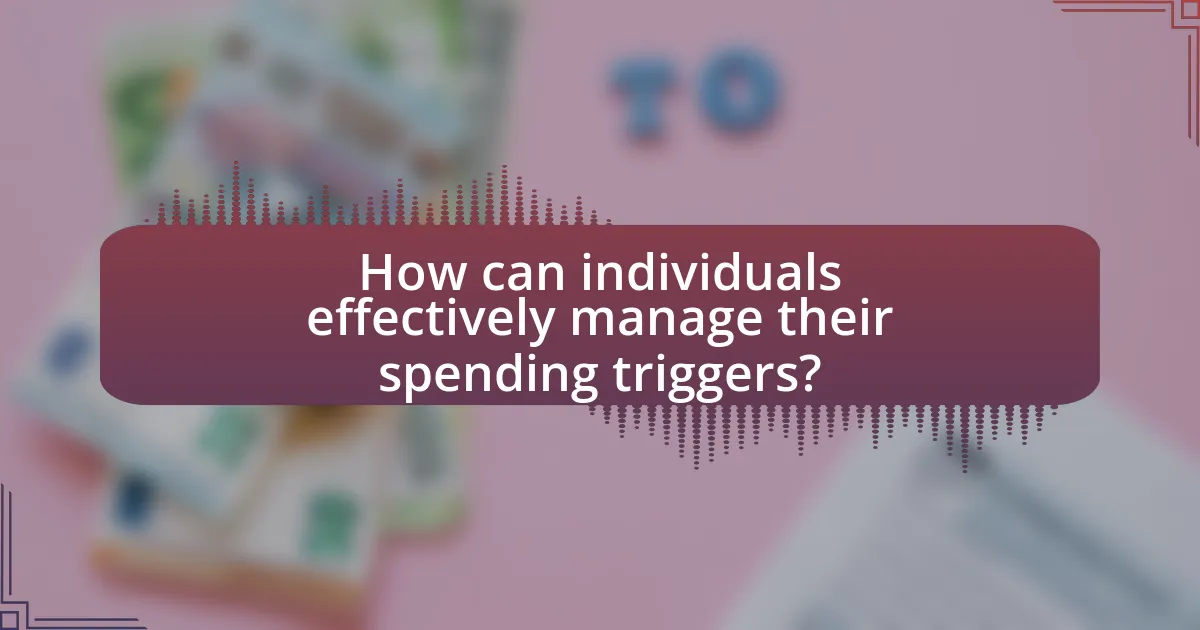
How can individuals effectively manage their spending triggers?
Individuals can effectively manage their spending triggers by identifying and understanding the emotional and situational factors that lead to impulsive purchases. Recognizing specific triggers, such as stress, boredom, or social influences, allows individuals to develop strategies to counteract these impulses. For instance, a study published in the Journal of Consumer Research found that individuals who kept a spending diary were more aware of their triggers and made more conscious spending decisions. Additionally, implementing techniques such as creating a budget, setting spending limits, and practicing mindfulness can further help individuals control their spending behaviors.
What practical techniques can help control spending impulses?
Practical techniques to control spending impulses include creating a budget, implementing a waiting period before purchases, and using cash instead of credit cards. Establishing a budget helps individuals track their income and expenses, providing a clear framework for spending limits. A waiting period, such as 24 hours, allows time for reflection on the necessity of a purchase, reducing impulsive decisions. Additionally, using cash can create a tangible sense of spending, making individuals more aware of their financial limits compared to the abstract nature of credit cards. Research indicates that these strategies can significantly reduce impulsive buying behavior, as they encourage mindful spending and financial awareness.
How can budgeting tools assist in managing spending triggers?
Budgeting tools assist in managing spending triggers by providing users with a structured framework to track and analyze their expenses. These tools enable individuals to identify patterns in their spending behavior, allowing them to recognize specific triggers that lead to impulsive purchases. For instance, a study by the National Endowment for Financial Education found that individuals who use budgeting tools are 50% more likely to stick to their financial goals, as they can visualize their spending habits and make informed decisions. By categorizing expenses and setting limits, budgeting tools empower users to develop greater awareness of their financial habits, ultimately reducing the likelihood of succumbing to spending triggers.
What role does goal setting play in effective budgeting?
Goal setting is crucial in effective budgeting as it provides a clear direction and purpose for financial planning. By establishing specific, measurable, achievable, relevant, and time-bound (SMART) goals, individuals can prioritize their spending and allocate resources more efficiently. Research indicates that people who set financial goals are more likely to adhere to their budgets, as they have a tangible target to work towards, which enhances motivation and accountability. For instance, a study published in the Journal of Economic Psychology found that individuals with defined financial goals saved 33% more than those without clear objectives, demonstrating the significant impact of goal setting on budgeting success.
What are some common pitfalls to avoid when budgeting?
Common pitfalls to avoid when budgeting include underestimating expenses, failing to track spending, and not adjusting the budget regularly. Underestimating expenses can lead to financial shortfalls, as many individuals overlook variable costs such as groceries or utilities, which can fluctuate. Failing to track spending results in a lack of awareness about where money is going, making it difficult to identify areas for savings. Not adjusting the budget regularly can cause it to become outdated, as personal circumstances and financial goals change over time. According to a study by the National Endowment for Financial Education, 60% of Americans do not maintain a budget, highlighting the importance of these pitfalls in effective financial management.
How can emotional spending be minimized?
Emotional spending can be minimized by implementing a structured budget and identifying emotional triggers. Creating a budget helps individuals allocate funds for necessary expenses and discretionary spending, reducing impulsive purchases driven by emotions. Additionally, recognizing specific emotional triggers, such as stress or boredom, allows individuals to develop alternative coping strategies, such as engaging in hobbies or exercising, rather than resorting to shopping. Research indicates that individuals who maintain a budget are less likely to engage in emotional spending, as they have a clearer understanding of their financial limits and goals.
What strategies can prevent overspending during emotional times?
To prevent overspending during emotional times, individuals can implement strategies such as setting a strict budget, using cash instead of credit cards, and establishing a waiting period before making purchases. A strict budget helps individuals allocate funds for necessary expenses and discretionary spending, reducing impulsive purchases. Using cash limits the ease of spending and encourages more mindful transactions, as physical money feels more tangible than digital payments. Establishing a waiting period, such as 24 hours, allows individuals to assess their emotional state and reconsider the necessity of the purchase, which can significantly reduce impulse buying. Research indicates that emotional spending often leads to regret and financial strain, highlighting the importance of these strategies in maintaining financial health.
What are the best practices for maintaining a successful budget?
The best practices for maintaining a successful budget include setting clear financial goals, tracking all income and expenses, and regularly reviewing and adjusting the budget. Clear financial goals provide direction and motivation, while tracking income and expenses ensures awareness of spending habits. Regular reviews allow for adjustments based on changing circumstances, which is essential for staying on track. According to a study by the National Endowment for Financial Education, individuals who actively track their spending are more likely to stick to their budgets and achieve their financial goals.
How can regular reviews of spending habits enhance budgeting success?
Regular reviews of spending habits enhance budgeting success by providing individuals with insights into their financial behaviors and patterns. By consistently analyzing expenditures, individuals can identify unnecessary spending, recognize triggers for impulse purchases, and adjust their budgets accordingly. Research indicates that people who regularly track their spending are 50% more likely to stick to their budgets, as they become more aware of their financial decisions and can make informed adjustments. This awareness fosters accountability and encourages more disciplined financial habits, ultimately leading to improved budgeting outcomes.
What tips can help sustain motivation in budgeting efforts?
To sustain motivation in budgeting efforts, set clear, achievable goals that provide a sense of purpose. Research indicates that specific, measurable goals enhance commitment and focus, making it easier to track progress and celebrate small victories. Additionally, regularly reviewing and adjusting your budget can help maintain engagement, as it allows for reflection on spending habits and reinforces accountability. Studies show that individuals who actively monitor their financial progress are more likely to stay motivated and adhere to their budgeting plans.
